
Potter
Street: A New Address for the Biosciences
Scientists Look to
Arctic Rivers to Understand Climate Change
Potter Street: A New Address for the Biosciences
One of the explosive growth areas in research at Berkeley Lab and at its campus neighbor is biology. This is especially true for multidisciplinary efforts in synthetic biology, cell and molecular biology, cancer research, and quantitative biology. Over the next several years, the world is likely to become very familiar with the address 717 Potter Street in Berkeley, where much of the action in these fields will take place.
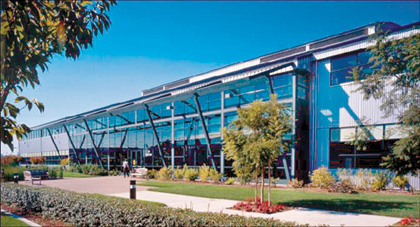 Berkeley Lab and UC Berkeley scientists will occupy lab space in a
building renovated for biotech research, previously leased by the
Bayer Corporation.
Berkeley Lab and UC Berkeley scientists will occupy lab space in a
building renovated for biotech research, previously leased by the
Bayer Corporation.
The UC Berkeley campus and the Lab combined forces to find and lease from Wareham Develop-ment of San Francisco 72,000 square feet of specialized research and development laboratory space in a building there, one that is perfectly suited to the technical demands of today’s biosciences. Previously leased to pharmaceutical giant Bayer Corporation, the building — one of 15 on Wareham’s West Berkeley life sciences “campus” — was fully renovated for biotech research in 1997. The space is in excellent condition, with large general laboratories, adjacent cold and warm rooms, viral suites, tissue culture rooms, lab benches and hoods, and other equipment and furniture.
Berkeley Lab scientists, largely from the Life Sciences and Physical Biosciences divisions, will occupy most of the second floor. Among those researchers will be Life Sciences Director Joe Gray and former director Mina Bissell, Mary Helen Barcellos-Hoff, Life Sciences Deputy Director Damir Sudar, and Paul Yaswen. Joint appointees with UC Berkeley who will move to Potter Street include Carlos Bustamante, Jay Keasling, Adam Arkin, Daniel Fletcher, plus administrative and management staff from Physical Biosciences.
The Lab will also provide a bioinstrumentation group. In all, about 200 scientists and staff are expected to move to Potter Street beginning in April.
The initial five-year term of the lease includes options to renew for up to 20 years. The Laboratory’s tenure will depend upon the progress of capital projects on the Hill.
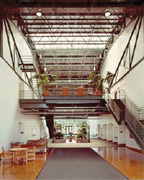
The lobby of the Potter Sreet building
The need to seek the offsite lab space was driven by unprecedented growth in biology programs at both institutions and by their inability to provide quality research space for those programs, primarily housed in Lab buildings 74, 83 and the Donner Laboratory on campus. Such space limitations have restricted researchers’ ability to be competitive for new grants, recruit and retain quality scientists, and conduct work sponsored by the DOE and the National Institutes of Health.
One of Potter Street’s selling points was its proximity to other institutions that might engage in collaborative research, such as Bayer, Xoma, Dynavax, UC San Francisco and its Mission Bay campus, Chiron, and other biotech firms.
The vacated onsite space at the Lab will allow for consolidation of the Life Sciences Radiation Biology program, return of the biosciences administrative staff to the main site from downtown, and relocation of functions from the Bevatron (Building 51) in anticipation of its demolition.
The Physical Biosciences Division’s Synthetic Biology Department will be centered at Potter Street, positioning it for future DOE funding in areas such as environmental remediation and renewable energy. The new building will also enable programs in biological and environmental research such as Genomics: GTL science, low-dose radiation, DNA repair, and functional genomics.
The UC Board of Regents approved the lease proposal in November, and the DOE concurred in February. Negotiations between the parties concluded last week.
Scientists Look to Arctic Rivers to Understand Climate Change
As soon as Berkeley Lab’s Christopher Guay stepped out of the schoolhouse and onto the streets of the small Siberian village, he knew something was up. It was late May 2004, and the hardy folks who live above the Arctic Circle on the banks of the Lena River were abuzz. The river ice was breaking. Spring had come.
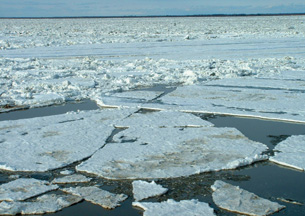 Spring comes to Russia's Lena River, and with it a surge of dissolved
metals.
Spring comes to Russia's Lena River, and with it a surge of dissolved
metals.
For the villagers of Zhigansk, Russia, the car-sized chunks of ice floating downstream hastened the start of the fishing season. For Guay, a chemical oceanographer in the Earth Sciences Division, it meant the clock was ticking. He had been there since mid-May, drilling through the ice and measuring the river’s concentrations of various dissolved metals such as barium, cadmium, and copper. On this day, he and his fellow scientists were taking a break from their work. But now it was time to get back to the river, and the sooner the better. With the spring thaw comes a surge in runoff and a renewed influx of metals.
His work is part of a multinational project to analyze the chemistry of the six largest rivers that drain the vast watershed of the Arctic Ocean: Alaska’s Yukon River, Canada’s Mackenzie River, and Russia’s Kolyma, Lena, Ob’, and Yenisey Rivers.
The project is called PARTNERS, for Pan-Arctic River Transport of Nutrients, Organic Matter, and Suspended Sediments. Launched in 2002 and funded by the National Science Foundation, it is led by Bruce Peterson of the Marine Biological Laboratory in Woods Hole in Massachusetts, and includes two dozen scientists from institutions in the U.S., Canada and Russia.
The goal of the five-year effort is to catalog each river’s unique mix of metals, nutrients, microbes, and oxygen isotopes. This information, a sort of chemical fingerprint, will allow scientists to track how the rivers’ freshwater runoff impacts the Arctic Ocean.
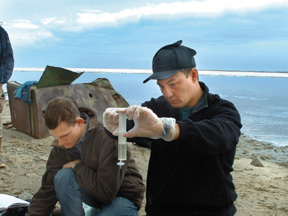
Christopher Guay (right) and Russian scientist Alexey Kleschenkov
take samples of dissolved metals in the Lena River.
“This is important, because what happens to the Arctic Ocean plays a major role in what happens to the rest of the world,” says Guay.
Computer models indicate that global climate change could lead to an increase in precipitation and melting ice at high latitudes. If this happens, more fresh water from waterways such as the Lena river will course into the Artic Ocean, which already receives 10 percent of the globe’s continental runoff, even though its area accounts for only 2 percent of the Earth’s oceans. Add even more fresh water to the Arctic Ocean, and some scientists believe that a string of feedback mechanisms could alter the planet’s ocean circulations, which, in turn, will impact the planet’s climate. This engine of change is already running. Scientists estimate that freshwater runoff from the six rivers increased 7 percent from 1936 to 1999.
“The Arctic Ocean is relatively small and remote, but it is a major player in the planet’s climate,” says Guay. “And it is an early indicator of what may happen elsewhere.”
This is why Guay hurried to the banks of one of Russia’s longest rivers last spring and obtained samples of its dissolved metals. Right now, the group is trying to establish a baseline of each river’s biogeochemical fingerprint from season to season and year to year. The metals and other chemicals that make up these fingerprints can be used as tracers that allow scientists to “see” a specific river’s freshwater contribution to the Arctic Ocean and neighboring oceans. For example, the Mackenzie River’s barium-laden waters are easily detected and can be used to track oceanic flows for thousands of miles, from the river’s mouth to the North Atlantic. If these barium levels change, perhaps the ocean current is changing — a possible harbinger of climatic changes to come.
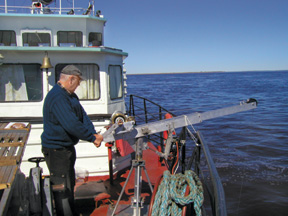 After the ice melts, the team takes to the river in boats. Here, Russian
scientist Alexander Zhulidov lowers a sampling instrument into the
depths.
After the ice melts, the team takes to the river in boats. Here, Russian
scientist Alexander Zhulidov lowers a sampling instrument into the
depths.
“We need to know if the tracer signals are changing,” says Guay. “And if there are changes, how much of it is due to natural variability or anthropogenic causes.”
So for a few weeks last spring, while other scientists involved in the project worked the banks of the Yukon and other rivers, Guay took daily samples before, during and after Lena’s spring thaw. This information will help fill a void surrounding what’s known about the chemistry of Russian rivers that drain into the Arctic Ocean, which is currently based on outdated and possibly inaccurate measurements.
Ultimately, the data he collected will be a small part of a much larger puzzle that includes metal measurements taken at other times of the year and at other rivers, as well as measurements of microbes, nutrients, and oxygen isotopes. When the study is completed in 2007, the group will have compiled a database of river biogeochemistry encompassing six arctic rivers and spanning four years.
“We can compare this time series of metals and other tracers to future data and see how the rivers are changing over time,” says Guay. “This could help us determine how climate change affects arctic watersheds, and how this affects the Arctic Ocean and beyond.”
Magnet’s Journey Through Lab History
 Shirley Ashley in a 1959 photo from the Magnet.
Shirley Ashley in a 1959 photo from the Magnet.
When Shirley Ashley began her career at the Lab back in 1947, it was not unusual, she recalls, for “a lowly typist like me who had the good fortune to have typed the scientific manuscripts for the learned men and women” to chat with Ernest Lawrence on her walks up and down the Hill. Those were happy days for Ashley, who developed friendships and bonds to the Lab that would last a lifetime. After retiring, she served for 17 years as secretary of the Ex-Lers, the Lab’s retiree association. “The previous secretary dumped all these papers on me,” she said. There they sat undisturbed for decades, until Ashley decided to start sifting through the piles, where she stumbled on a little treasure.
“When I started looking through it, I didn’t do anything else all day,” she says. What she found was an almost complete collection of the Magnet, the publication for Lab employees during the late 1950s and 1960s. “I got a real kick out of finding all these people I knew. After working here 32 years, I still feel very close to the Lab.”
The Magnet was named for what was the centerpiece of work performed here, and still is to a large extent. “The magnet is one of the most valuable servants of man-kind,” the magazine explained upon its launch. “At this Labora-tory, it is our lifeblood.”
Instead of keeping this precious collection, Ashley contacted the Communications Department and donated it to the Laboratory. Not surprisingly, her generous gift had the same effect on us as it did on her. Coming in contact with those pristinely preserved glossy pages makes one an instant witness to history — a golden era of science at this Laboratory as well as in the world at large.
Once you flip through the pages, it’s almost impossible to stop. From the discovery of new elements and particles to the awarding of four Nobel Prizes to Lab scientists, to President Kennedy’s historic visit to the Lab, it’s all chronicled there. So is the passing of Ernest O. Lawrence and the naming of the laboratory in his honor, the construction of now-familiar landmarks all over the Hill, and the inexorable march of technology.
But the Magnet did more than just inform readers about all these goings on. The Lab’s first employee paper heralded a new era in communications on the Hill, fostering a sense of community through a shared publication, a proud legacy continued in publications such as the View.
“In the Magnet we at last have a means of learning about one another’s programs and becoming a more closely integrated group,” wrote Ernest Lawrence in the inaugural issue of November 1957. “I hope that the Magnet will … give us a better understanding of the broad, human story of our Laboratory.”
Lawrence’s words from half a century ago could just as well have been written today, for they speak to the same desire of people to connect as human beings in the workplace. If anything, that need is even greater today as the Lab has grown and diversified, and finding common ground with our peers can be a greater challenge. Back in 1960, for instance, Lab employees participated in some two dozen clubs — everything from chess, bowling and golf, to choruses, horseshoes, skiing, and touch football. Dances were frequent, large-scale events, drawing crowds of 600 people. And Livermore Lab (which the Magnet covered as well) had its own 26-person symphony.
But the employees’ association is still here, and so are the dances and golf tournaments, as well as new activities and events. Looking back at the social life of the Laboratory is part nostalgia, part humbling reminder of how little we have changed after all.
Lawrence’s vision of what we now refer to as a multidisciplinary approach to science was realized beyond his dreams, at his laboratory more than any other. But as a result of this progress, today’s Berkeley Lab — with its 4000-plus employees, more than a dozen scientific divisions and four national user facilities — is not the same institution as the UC Rad Lab of half a century ago. That’s why the Magnet would eventually morph into other print publications that would reflect the needs of the times, such as Research Review, Currents (in its various reincarnations), and now the View.
And while technologies have advanced by leaps unfathomable a few decades ago, the magnet itself is still a driving force behind much of the science at the Lab; but it now serves new masters towards different purposes and sits at the core of very different machines. At the Advanced Light Source, for example, scientists from around the world probe mysteries of materials at scales never before thought possible, with applications in most fields of science.
But the foundation for much of this wondrous research was set by Lawrence and his fellow scientists more than half a century ago, and the Magnet captured many of the ensuing “aha! moments” in an invaluable historical archive that still serves as a source of inspiration for those of us in the business of informing and linking people through the magic of the printed word.
Lessons from Madeleine Jacobs
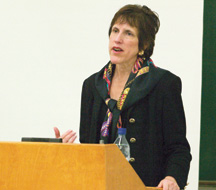 Jacobs
Jacobs
Lesson #1: “Never do anything just to please your mother, or anyone else for that matter.” Sage advice from Madeleine Jacobs, who in 2003 became the first woman executive director and CEO of the American Chemical Society, the world’s largest scientific society.
Last Friday, the chemist, science journalist, and advocate of gender equity in science revealed the lessons she’s learned during a life devoted to science, an interest that began in the 1950s while watching Mr. Wizard on TV.
“I was 10 years old when it became crystal clear to me that all that is important in life involved chemistry,” said Jacobs. “I also learned form early on that I could do anything I set my mind to.”
That determination has led to a long list of accomplishments, but not without paying her dues. After graduating from George Washington University with a degree in chemistry in 1968, she completed coursework for a master’s degree in organic chemistry at the University of Maryland. Along the way, she supported herself by capturing and dissecting cockroaches to track the effects of pesticides for the Department of Agriculture.
From there it was all uphill. In 1969, she was hired as a reporter for Chemical & Engineering News after sidestepping the receptionist and approaching the editor as he exited the elevator — a bold move that leads to another lesson: “Never take no for an answer.”
The job allowed her to combine her love of science with her love of writing. A string of science writing jobs then led her to become director of public affairs for the Smithsonian Institute before returning to Chemical & Engineering News in 1995 as the first woman editor-in-chief. Eight years later, she became head of the American Chemical Society.
How did she get to where she is today? There are clues in the 10 lessons she recounted during her talk in the Building 50 auditorium. Among them: No matter what career you choose, you must do it for something other than money. Follow your intuition; it is often better than relying on the facts. Believe in yourself. And carpe diem.
Jacobs also believes that a little help never hurts, especially if more women are to follow in her footsteps. “It’s important for successful women to help women who are struggling,” she said.
A Search Engine that Thinks Like Us . . . Almost
There’s a reason scientific progress is slow: It may take weeks for a biologist to comb through a stack of journal articles and discover that one gene is functionally related to another. This relationship could lead to a new way to fight a disease — but not if it remains hidden.
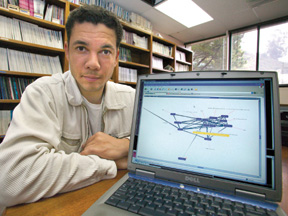
Kasian Franks helped develop a search engine that may do in minutes
what now takes a biologist days.
Berkeley Lab researchers hope to accelerate this needle-in-a-haystack hunt with an innovative search engine that simulates the way scientists think. It’s called GenoPharm, and rather than search through data by keyword, the way Google does, it searches by association, like scientists do.
“GenoPharm mimics the way biologists search through biomedical literature for connections between genes,” says Kasian Franks of Berkeley Lab’s Life Sciences Division, who developed the software with Life Sciences biologists Mina Bissell and Connie Myers. “It could enable a biologist to do in minutes what now takes them days.”
To use GenoPharm, a person enters a gene symbol and selects a context, such as “molecular function” or “therapeutics.” The result is a web of relationships, with genes that appear more closely together in scientific literature appearing more closely together in the web. Plug in “BRAC-1,” for example, which is a gene that plays a role in breast cancer, and a GenoPharm search yields a sprawling network of associations. Some connections are known, some are not. By following one thread of relationships, a researcher can learn that BRAC-1 is linked to a gene that performs DNA binding functions, which is related to another gene, which is the target of a drug that slows the growth of cancer cells.
“We are able to find indirect connections between genes and therapies that haven’t been noticed before,” says Franks.
The idea for a search engine that maps associations came to Franks by way of his three young children. He noticed how each child processed information by taking two pieces of knowledge, combining them, and coming up with something new. Franks wondered whether he could get a computer to do the same thing — that is, help a biologist connect two genes in a previously unknown way.
He turned to the Geneva Development System, something akin to a search engine factory developed at Berkeley Lab to find contextual relationships in biomedical databases. The system measures the proximity of every word to every other word in millions of documents, and, when asked, reveals how a specific word is related to others. In developing the system, the team drew its inspiration from the way a person’s brain works when asked to list the words associated with the word “sky.” Nearly always, a person will immediately respond with “blue” and “cloud,” largely because they are accustomed to seeing these words very near “sky” in text.
“We are literally mimicking the process of auto-association, which is a cognitive principle that describes how a human stores and recollects information,” says Franks.
In this manner, GenoPharm focuses the Geneva Devel-opment System’s powers on a database of 70,000 gene descriptions and PubMed functional references. Once an associative network surrounding a gene is generated, a separate database maps relevant diseases and therapies to each gene, creating an interlinking web of genes, diseases, and their therapies.
The system is still in the developmental stage. As Franks says, it isn’t easy getting a computer to do what comes naturally to a child, but his goal is to narrow the gap separating how computers and people process information.
“The successful outcome of this effort is in part due to the support of Mina Bissell’s Lab, which has encouraged unique multidisciplinary approaches in biological research,” says Franks. “We want to create a biomimetic search engine. And we want to show how it is different than what we have today. After all, who needs 100,000 documents if they lack context?”
JGI Launches Powerful Data Management System for Microbes
To more effectively manage the flood of data emanating from countless microbial genome sequencing projects advanced by centers around the globe, the Joint Genome Institute (JGI) has introduced a new Integrated Microbial Genomes (IMG) data management system.
“As the number of microbial genomes sequenced continues to rise, the genome analysis process becomes the rate-limiting step,” said JGI Director Eddy Rubin. “By integrating publicly available microbial genome sequence with JGI sequences, the IMG system offers a powerful data management platform that supports timely analysis of genomes from a comparative functional and evolutionary perspective.”
The JGI is currently producing nearly one-quarter of the microbial genome projects worldwide, more than any other single institution. The IMG system, the fruit of a collaboration between the JGI and Berkeley Lab’s Biological Data Management and Technology Center (BDMTC), currently features more than 200 organisms, with an additional 200 already in the queue for 2005.
“The value of genome analysis depends on the quality of the data, and increases with the number of genomes available for comparative analysis,” said Victor Markowitz, head of BDMTC, who led the IMG development effort.
“IMG is so fundamental, that the power of making clean data available to our collaborators and the scientific community will be totally devastating,” said Nikos Kyrpides of JGI’s Microbial Genome Analysis Program (MGAP), who provided scientific leadership and overall coordination for the IMG project. MGAP manages the IMG’s data content and curation and helped develop the system, with additional support provided by JGI’s Microbial Ecology and Genome Data System groups.
Gary Andersen, leader of the Earth Sciences Division’s Molecular Microbial Ecology group, uses IMG for a project sponsored by the DOE — Genomics: GTL program — which explores the potential of a particular microbe, Caulobacter crescentus, for heavy-metal remediation in wastewater. “The IMG system is very useful in identifying potential functions for genes that we find upregulated in Caulobacter crescentus strains exposed to heavy metals. Examining the neighborhood around a gene of unknown function in multiple species selected from the organism browser may yield clues of what its role might be in your particular species,” said Andersen. “The interface is quite intuitive, which is a benefit for someone like me who does not like to read manuals.”
The IMG team will hit the road during March and April to familiarize the user community with the IMG system. One stop will be a March 11 presentation at Berkeley Lab’s Washington D.C. office.
Plutonium Decontamination Agent Characterized at ALS
In an ongoing effort to design and synthesize chemical substances that can safely and effectively remove plutonium and other radio-active materials from the human body or from the environment, Berkeley Lab scientists have made an important advance. Using the exceptionally bright and intense x-ray beams of the Advanced Light Source (ALS), they have determined the crystal structure of a molecular complex that has shown promise as a sequestering agent for plutonium and other members of the actinide family of elements.
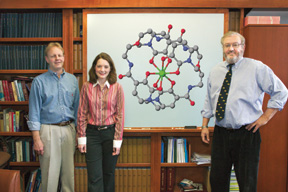 David Shuh (left), Anne Gorden and Ken Raymond used the ALS to determine
the crystal structure of a molecular complex that has shown promise
as plutonium sequestering agent.
David Shuh (left), Anne Gorden and Ken Raymond used the ALS to determine
the crystal structure of a molecular complex that has shown promise
as plutonium sequestering agent.
“This is the first plutonium complex that has been characterized using single crystal x-ray diffraction with a synchrotron radiation source like the ALS,” says Anne Gorden, the Glenn T. Seaborg Center Postdoctoral Fellow with Berkeley Lab’s Chemical Sciences Division (CSD), and one of the co-authors of a paper on this work which appears in an upcoming issue of Chemistry, a European Journal.
“Taking advantage of our ability to do x-ray diffraction at the ALS, we would like to generate a library of complexes with plutonium or other actinides that will aid in the design of novel sequestering systems, and also provide benchmarks for additional structural studies with actinides,” Gorden says.
Collaborting with Gorden on this research and co-authoring the paper in Chemistry were David Shuh, a staff scientist at the ALS, plus Bryan Tiedemann, Richard Wilson, Jide Xu and Kenneth Raymond, all of whom hold appointments with the Seaborg Center, the UC Berkeley Chemistry Depart-ment, or both.
Actinides — the radioactive chemical elements that span from actinium to lawrencium on the periodic table — have generated a great deal of interest in recent years. Their use in nuclear power plants as well as their military applications have raised a variety of environmental and health concerns, which have been further compounded by their potential use in “dirty bomb” terrorist weapons. Concerns are especially high over plutonium because of its alpha radioactivity and the complexes it forms with bone and tissue once a person has ingested or inhaled it.
“The need for agents that will bind with plutonium and other actinides and immobilize them for removal from living tissue, or allow them to be sequestered from the environment, is more urgent than ever,” says Gorden. “However, scientists first need to develop a better understanding of basic actinide chemistry.”
One of the best ways scientists have of obtaining detailed information on the atomic structure and chemical bonding of molecular complexes is single-crystal x-ray diffraction. A beam of x-rays sent through a crystallized sample of the complex is scattered (diffracted) by the atoms in the crystal, creating a pattern that can be imaged. This diffraction pattern can then be translated by computer into highly detailed, graphic 3-D images of the complex.
“Because it is very difficult to crystallize plutonium and other actinide complexes, being able to do the diffraction work on a synchrotron like the ALS is a huge advantage,” says Gorden. “We can work with crystals as small as 15 microns to a side, and collect data in about 45 minutes that would take 10 hours or more using a conventional x-ray source.”
Gorden and her colleagues studied their crystals with a state-of-the-art diffractometer at the ALS’s Small-Crystal Crystallographic Beamline (11.3.1), which uses a bending magnet to provide intense beams of monochromatic x-rays in the energy range of 7 to 17 kiloelectron volts (keV). This experimental setup was developed by UC Berkeley crystallographers Allen Oliver and Fred Hollander.
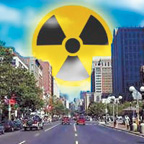
Concern over the use of plutonium or other actinides in a “dirty
bomb” terrorist weapon has made the need to develop safe and
effective sequestering agents greater than ever.
The plutonium crystals that Gorden and her colleagues investigated were ether-bridged hydroxy-pyridonate ligands — nicknamed HOPO — which are based on the chelating unit found in siderophores, small molecules that are secreted by bacteria to extract and solubilize iron. For the past two decades, collaborator Ken Raymond has been leading investigations into the development of HOPO and other complexing agents that would encapsulate plutonium into tightly bound, cage-like complexes.
In tests on mice, HOPO complexes have stood out as being far more effective at removing plutonium and other actinides from the body than the current approved treatments. Also, HOPO complexes could be administered orally via a pill, and experiments have demonstrated that it may even remove plutonium that has been deposited in bone.
“We expected the plutonium HOPO complex to have the same crystal structure as a cerium HOPO complex, but found they were quite different, even though crystals of both were grown in water,” says Gorden.
Cerium, a member of the non-radioactive lanthanide family of elements, has been used as a safe stand-in for plutonium in structural studies. Although the two elements have different chemistry, the Ce(IV) and Pu(IV) ions have a similar size. The Berkeley scientists plan to continue their studies with lanthanides and actinides to determine if the differences in these complexes are due to solvent effects or the interactions between the ligands and these heavy metals.
“Our work with the plutonium HOPO complex indicates that a library of actual actinide structures will be necessary for developing effective actinide decorporation or sequestering agents,” Gorden says.
Cancer Collaboration Announced
UCSF’s Comprehensive Cancer Center and Berkeley Lab’s Life Sciences Division Make it a Little Less Informal
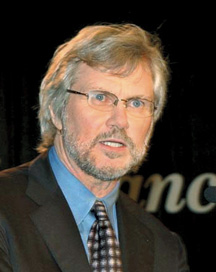 Frank McCormick heads UCSF’s Comprehensive Cancer Center.
Frank McCormick heads UCSF’s Comprehensive Cancer Center.
Frank McCormick, director of the Comprehensive Cancer Center at UC San Francisco, which is supported by the National Cancer Institute (NCI), announced on February 11 a new affiliation with Berkeley Lab’s Life Sciences Division, headed by Joe Gray. In a video newsletter announcing the relationship McCormick remarked that the connection “initially will be as an informal affiliation, but we hope it will get blessed by the NCI when the NCI reviews our joint programs in 2007.”
McCormick cited two reasons “for embarking on this process at this time.” First are new guidelines issued last fall by NCI, encouraging cancer-center affiliations with nearby institutions where there exists what McCormick called “a clear synergy between research programs.”
NCI bestows the Comprehensive Cancer Center designation on organizations that integrate laboratory, clinical, and population-based cancer research and have extensive outreach and educational programs; like UCSF, most also provide clinical care. While noting that NCI favors “one cancer center per institution,” the new guidelines acknowledge that “mergers and strategic alliances blur long-familiar institutional identities;” consequently centers have become so complex that formalizing strategic affiliations is desirable.
The second reason for the announcement, McCormick said, is that Joe Gray, formerly a professor in the Department of Laboratory Medicine and Radiation Oncology at UCSF and still adjunct professor there, continues to lead the breast oncology program he established at UCSF before he came to Berkeley Lab. When Gray decided to accept directorship of the Life Sciences Division at Berkeley Lab, McCormick said, “he and I decided that we would make every effort to keep our research programs closely integrated.”
McCormick cited Berkeley Lab’s many cancer researchers who are already involved with the Compre-hensive Cancer Center’s research, including Mina Bissell and Mary Helen Barcellos-Hoff, among others, and who are attracted in part by the clinical programs at UCSF. “But it will really go way beyond that,” he said. “For example, in the area of DNA repair, both UCSF and LBNL have leadership positions … and we’re imagining a new program in that area.” He listed Berkeley Lab expertise in “bioengineering, imaging, genome analysis, nanotechnology, data management, and many other areas which will add great value to our programs.”
The affiliation will remain informal until UCSF’s current grant is up for renewal and the NCI makes a site visit in 2007. If Berkeley Lab and UCSF can demonstrate to the NCI that they have successfully integrated cancer research programs at that time,
the relationship will become official; both institutions would benefit from NCI’s recognition of the affiliation when the UCSF Comp-rehensive Cancer Center grant is renewed.
Famed Chemist Leo Brewer Dies
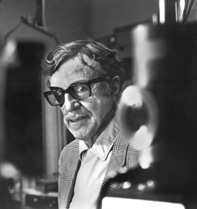 Leo Brewer
Leo Brewer
Leo Brewer, an award-winning, long-time chemist with Berkeley Lab and UC Berkeley, died of natural causes on February 22 at Deer Hill Care Home in Lafayette. He was 85. Services were held for him last Friday at Oakmont Memorial Park in Lafayette.
Throughout more than five decades of research, Brewer established himself as the founder of modern high-temperature chemistry and a passionate student of California native plants.
“Leo Brewer was one of the most principled and generous persons I have ever known,” said former Berkeley Lab Director Andy Sessler. “During my time in the front office he was associate director for the Inorganic Materials Research Division. He was a persuasive leader, not by the force of his presentation, but by the simple validity of his ideas.”
Brewer was born in 1919 in St. Louis, Missouri. He received his undergraduate degree from the California Institute of Technology in 1940. On the recommendation of Linus Pauling, he entered the graduate program at UC Berkeley and earned his Ph.D. only 28 months later. He immediately joined the war-time Manhattan Project, where he headed a group charged with predicting the possible high-temperature properties of newly discovered plutonium (then available only in trace amounts), and with providing materials for a crucible that would contain molten plutonium without contaminating it. He solved the crucible problem by developing new sulfides of thorium and cerium.
A unique combination of theory with experimentation would mark Brewer’s research throughout his distinguished career. He joined the UC Berkeley faculty in 1946 and became a professor of chemistry in 1955. He began his affiliation with Berkeley Lab as a consultant in 1950. In 1961 he became head of the Lab’s Inorganic Materials Division, a position he held until 1975. In 1961, he received the E. O. Lawrence Award for his high-temperature thermodynamics research.
While the primary focus of Brewer’s research was on high-temperature thermodynamics, materials science, studies of metallic phases, and development of metallic bonding theory, he was also involved at different points in his career with astrophysics and ceramics. His research was published in nearly 200 articles and in his revision of the well-known book by G. N. Lewis and Merle Randall on thermo-dynamics. He received many honors in addition to his Lawrence Award, and upon his official retirement in 1989 he was presented with the Berkeley Citation.
For all of his duties as a scientific researcher and administrator, Brewer remained a caring and gifted teacher who taught freshman chemistry as well as more advanced courses. In 1988 he received the Linford Award for Distinguished Teaching from the Electrochemistry Society.
Gabor Somorjai, a chemist with the Materials Sciences Division who won the National Medal of Science in 2002 for his ground-breaking surface-science research, credits Brewer for his career as a physical chemist.
“When I came to this country in 1956 from Hungary, Leo Brewer was my first teacher in thermodynamics,” Somorjai said. “His course made all the difference in the world to me and I owe him a lot. His impact on the field was tremendous, and it was his sponsorship that brought a surface science program to Berkeley Lab.”
Richard Zare, now an award-winning professor of chemistry at Stanford, was another of Brewer’s students.
“Leo Brewer was a gentle, kind, considerate, caring individual whose passion for science was contagious,” Zare said. “He wore a black eye patch over his right eye, brought about by removal of some malignant growth, I believe, which made his appearance quite formidable; but quickly I discovered a warm human being under this mask.”
In 1965, Brewer became one of the founding members of the Cali-fornia Native Plant Society, a state-wide nonprofit organization of amateurs and professionals who work to study and preserve California’s native flora. A species of manzanita is named after him.
Brewer is survived by his three children, Roger Brewer of Portland, Oregon, Gail Brewer of La Cañada, Calif., and Beth Gaydos of Cupertino, Calif., and six grandchildren. His wife, Rose, predeceased him in 1989.
Memorial contributions may be made to the Department of Chemistry at UC Berkeley (420 Latimer Hall, Berkeley, CA 94720-1460) or to the California Native Plant Society (2707 K Street, Suite 1, Sacramento, CA 95816-5113).
Outstanding Work Rewarded with OPAs
Twenty-six Lab employees, including individuals and teams, were honored recently with Outstanding Perfor-mance Awards, or OPAs, which are granted for significant achievements above and beyond regular job expectations. The most recent class of OPA recipients attended a January 27 reception hosted by Lab Deputy Director Pier Oddone. Pictured here are, left to right, Daniel Peterson, Azriel Goldschmidt, Sabah M. Hassan, Dwayne Ramsey, Adam D. Stone, Sara Mattafirri, Scott Bartlett, Christine A. Donahue, Sandra McFarland, Bruce Harteneck, June J. Wong, David McGraw, Edward E. Domning, Ana E. Tully, Simon A. Morton, Olivia Salazar, Pier Oddone, Alan F. Lietzke, and Brian V. Smith.
Daughters & Sons to Work Day
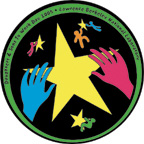
“Take Our Daughters and Sons to Work” Day (DSTW) will be held early this year on Thursday, March 10. Space is limited to 200 children and workshop assignments will be made on a first-come, first-served basis. The fee is $20 per child.
For more information on schedule, workshop descriptions, and registration information, see the DSTW website at http://www.lbl.gov/ Education/CSEE/dstw05/ or contact Joe Crippen at X816.
Berkeley Lab View
Published every two weeks by the Communications Department for the employees and retirees of Berkeley Lab.
Reid Edwards, Public Affairs Department head
Ron Kolb, Communications Department head
EDITOR
Monica Friedlander, 495-2248, msfriedlander@lbl.gov
STAFF WRITERS
Lyn Hunter, 486-4698
Dan Krotz, 486-4019
Paul Preuss, 486-6249
Lynn Yarris, 486-5375
CONTRIBUTING WRITERS
Jon Bashor, 486-5849
Allan Chen, 486-4210
David Gilbert, 925-296-5643
FLEA MARKET
486-5771, fleamarket@lbl.gov
Design
Caitlin Youngquist, 486-4020
Creative Services Office
Communications Department
MS 65, One Cyclotron Road, Berkeley CA 94720
(510) 486-5771
Fax: (510) 486-6641
Berkeley Lab is managed by the University of California for the U.S. Department of Energy.
Online Version
The full text and photographs of each edition of The View, as well as the Currents archive going back to 1994, are published online on the Berkeley Lab website under “Publications” in the A-Z Index. The site allows users to do searches of past articles.
Flea Market
AUTOS & SUPPLIES- ‘02 JETTA GLS, 5-sp, dk blue ext/blk leather int, 19,300 mi, still under factory warr 4yr/50,000, ac, all pwr, cruise, premium sound, fr & side air bags, lux package, moonrf, alloy whls, tint wind, alarm, garaged, $12,000/bo, 758-1510, Helen, X4435
- ‘01 CHRYSLER TOWN & COUNTRY LX minivan, gold, exc cond, 16,500 mi, auto, alarm, keyless entry, ac w/ rear air, all pwr, rear defrost & wiper, tint glass, tilt whl, cruise, am/fm/cass/ CD, dual fr air bags, roof rack, orig owner, $13,500/bo, Bill, X5531, 813-1973
- ‘00 CHRYSLER 300M SPORTS SEDAN, silver, 250 HP V-6, 77K mi, serviced by Chrysler, premium sound, chrome whls, exc cond, blue book value $11,200, asking $10,000, Ed, X7509
- HOUSING
- BERKELEY HILLS, short stay, bay view, furn rm, 17’x15’, priv ent, own bthrm, quiet neighbrhd nr UC/pub trans/shops, cooking facil in adj rm, pool table, workout mach, w/d, $900/ mo, incl linens, dishes, utils, phone, DSL, dish TV/VCR, no smok/pets, $325/wk, Carol, 524-6692
- BERKELEY HILLS, by wk/mo, quiet furn suite, 1 bdrm/1 bth, liv rm, kitchenette, eleg & spacious, bay views, DSL, cable, walk to UCB, Pierre, 387-4015, pchew@paccbell.net, www.bvsuite.com
- BERKELEY, 1 bl to UCB, lge, nicely furn 1 bdrm apt, computer & DSL, $1,575/mo incl all util, Jin 845-5959, jin.young@juno.com
- BERKELEY, resid community of scientists/staff/grad students, Hearst Commons, 1146-1160 Hearst, nr UC/ pub trans/BART, res parking, internet, studio townhouses w/ decks, furn can be provided at no cost, hardwd flrs, skylights, dw, ac, intercom, sec, units from $850, 848-5371, hearst.commons @jps.net, http://www.live-work.us/ cgi-bin/artbooks/berkeley.html
- CENTRAL BERKELEY, furn rooms, $350/wk or $850/mo, kitchen, laundry, TV, DSL incl, walk to LBL shuttle, shops, Jin 845-5959, jin.young@juno.com
- El CERRITO, 518 Liberty St, nr BART, 2 bdrms, 1 car garage, front yrd, back yrd, new paint/carpet, $1,395/ mo, J C Jeing, jc@structusinc.com, 526-7188
- ELMWOOD, share eleg, 11-rm house w/ 2 non-smok professionals, hardwd flrs, fp, sauna, music rm, guest rm, yellow Lab, back yrd w/ fishpond & trees, lge bdrm w/ walk-in closet, wkly shared dinners, $925/mo + dep & shared util/expenses, Tony, 841-4480
- NORTH OAKLAND, quiet, new 350 sq ft cottage w/ priv ent in backyard, garden, near all trans, no smok/pets, $825/ mo, ref checks & credit report req, 654-2863, sr_hd@gtcinternet.com
- OAKLAND, cottage for lease, 2 bdrms, liv room, kitchen, back yrd, laundry rm $1,100/mo + $1,100/dep, dep neg, Maritza, 530-2769 or (415) 973-3356
- MISC ITEMS FOR SALE
- ANTIQUE OAK DESK & CHAIR, good cond, $400, pic avail upon req, Gary, X4441
- COWBOY BOOTS, women’s leather size 9, 2 pair w/ butterflies, $20 each, exc cond, Valerie, X5268
- MICROWAVE, Whirlpool, white, 1.2 cu-ft, exc cond, $25; Panasonic 25” TV, wood case, exc pic & cond, $25; Panasonic compact stereo syst w/ 3-disc CD changer, dual cass, tuner & speakers, $50, Ron, X4410, 276-8079
- PRINTER, Epson Stylus Color 600 ink jet w/ cable, software for Mac/PC, manuals & 5 ink cartridges, bo; PowerMac 6500/275 128MB RAM, 6GB HD, 24x CD, 56k modem, floppy & zip drive, bo; animal cage, glass, ideal for reptiles, insects, 30”x13”x18”, lamp heater, bo; old metal steamer trunk, 23”x26”x42”, int drawers, clothes hangers, bo, Steve, X5064, 655-8379
- STAR WARS TRILOGY VHS, new in shrinkwrap, box set of 3 VHS tapes, $15/ bo, Ken, X7739, kdwoolfe@lbl.gov
- STEREO, Philips home theatre receiver, blk case, good work cond but display LED takes a few minutes to turn on, remote, $35; Philips 5-disc CD changer, blk case, good cond, remote $25, Dave, X7261, 654-7806
- WANTED
- PING-PONG TABLE, good cond; girl’s bike, good cond, Tennessee, X5013
- VACATION
- TAHOE KEYS, house, 3 bdrm, 2-1/2 bth, fenced yrd, quiet, sunny, skiing nearby, great views of water & mountains, $195/night, 2 night min, Bob, (925) 376-2211
People, Awards and Honors
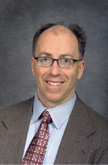 Neumark
Neumark
Daniel Neumark, director of the Lab’s Chemical Sciences Division, has been elected vice chair of the American Physical Society’s Division of Chemical Physics. His term will begin in March. Neumark’s research interests include the investigation of spectroscopy and dynamics of transition states and radicals and clusters using frequency and time-domain techniques. He is also a professor of chemistry at UC Berkeley.
 Ritter
Ritter
Lab physicist Hans Georg Ritter is the recipient of a Humboldt Research Award, which is conferred on scientists worldwide in recognition of lifetime achievements in research. The awardees are invited to carry out research projects at German institutions for periods of six months to a year in the hope of promoting international scientific cooperation.


 Blanch, Culler, Mamjumdar
Blanch, Culler, Mamjumdar
Berkeley Lab’s Harvey Blanch, David Culler and Arunava Majumdar have been elected to the National Academy of Engineering. Blanch, with the Environmental Energy Technologies Division, was honored for his advances in enzyme engineering, bioseparations, and biothermodynamics. Culler, with the Computational Research Division, was elected for his contributions to scalable parallel processing systems. And Majumdar, with the Materials Sciences Division, was cited for his contributions to nanoscale thermal engineering and molecular nanomechanics. All three are also faculty members at UC Berkeley.
 Raymond
Raymond
Lab chemical scientist and UC Berkeley professor Kenneth Raymond is the recipient of the Izatt-Christensen Award for his “highly innovative chemistry, which has expanded from relatively simple biomimetics to the beautiful catalytically active nanometer-scaled flasks.” The award will be presented this summer at the International Symposium on Macrocyclic Chemistry in Dresden, Germany.
Life Sciences postdoc wins women’s research award
Kumari Andarawewa, a postdoctoral research fellow in the Life Sciences Division, is one of two recipients of the Women in Cancer Research Brigid G. Leventhal Scholar Award, which honors first authors of meritorious papers selected for presentation at the annual meeting of the American Association of Cancer Research. Andarawewa works in the laboratory of Mary Helen Barcellos-Hoff. The award is based on her Ph.D. research conducted at France’s Institut de Génétique et de Biologie Moléculaire et Cellulaire on proteases and cancer cell cross talk.
 Lunsford, De Jager, Thornock
Lunsford, De Jager, Thornock
Nikki De Jager of the Security and Emergency Operations Group in the Environment, Health and Safety Division received a certificate of appreciation from DOE’s Office of Science (SC) in recognition of her efforts in planning and supporting an SC-wide workshop held at Berkeley Lab. Mark Thornock of the Office of Science and EH&S’s Dan Lunsford presented De Jager with the certificate, which was signed by SC Director Ray Orbach.